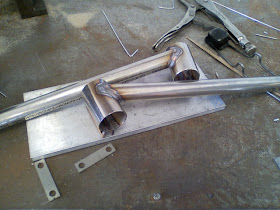I sometimes get the feeling that people who are into custom metalwork for their bikes or cars either think that making those parts is either extremely easy (I saw Jessie James build that tank with his English wheel!), or some sort of black magic. It's really neither, TV simplifies things too much, but working with sheet metal isn't anything more than a trade that isn't very common anymore, there's no magic to it at all. So I'm not revealing any secrets by showing how to make a pretty simple part, just doing a bit to preserve an old school skill.
So here's the step by step.
First I cut out a blank from some 14ga aluminum, I've worked out the shape over the years so I can make a seat just about the same size every time without having to trim much off at the end.
A cafe seat is typically just a hemisphere, which is really just a simple compound curve, there's a curve along the axis of the seat, and across the axis, a fender is really the same type of shape, just with one curve having a larger radius than the other!
To start forming the sheet, the middle needs to be stretched out, stretching the metal makes it thinner, so it takes up more surface area, if its edges can't move, it has to pop out, so that's how you "dome" metal.
Since I don't want to only stretch the metal (it would get really stupidly thin if I did), I shrink the edges to bring out the doming of the middle more. Shrinking actually makes the metal thicker, so it takes up less surface area, and tends to tuck in, so it pops any doming done to the sheet.
Shrinking is done by creating tucks at the edges, and then hammering them against an anvil, because of the shape of the tuck, the hammering actually gathers the metal together making it thicker, cool huh!
I use the English wheel mostly for small amounts of metal moving, it's a great tool for a specific job, it can dome metal, but not as fast as hammering, and it can't really shrink. It's this that makes me chuckle a little when some TV show shows some metals guy making a tank (but only shows them using the wheel!).
When the blank is shrunk and stretched a lot, it really needs to be wheeled to give it a smooth surface again, otherwise it's not really possible to keep stretching and shrinking efficiently.
This would be a rough wheeling, there's not much focus on getting a really nice planished finish, but just to bring the surface into some regularity. After this, the blank goes on to more shrinking and stretching, you can really see how much things can move!
After a few rounds of back and forth between the tuck shrinker, wheel and shotbag, I switch over to a larger radius anvil for the wheel (as close to the natural radius of the blank as you can get without going larger). It's with this setup and a constant light pressure that I planish the blank, it takes a lot of finesse and practice to get the blank really smooth and straight.
Now that the blank is formed, it's on to trimming to shape and building the rest of the seat! -I'll be posting that next.





























